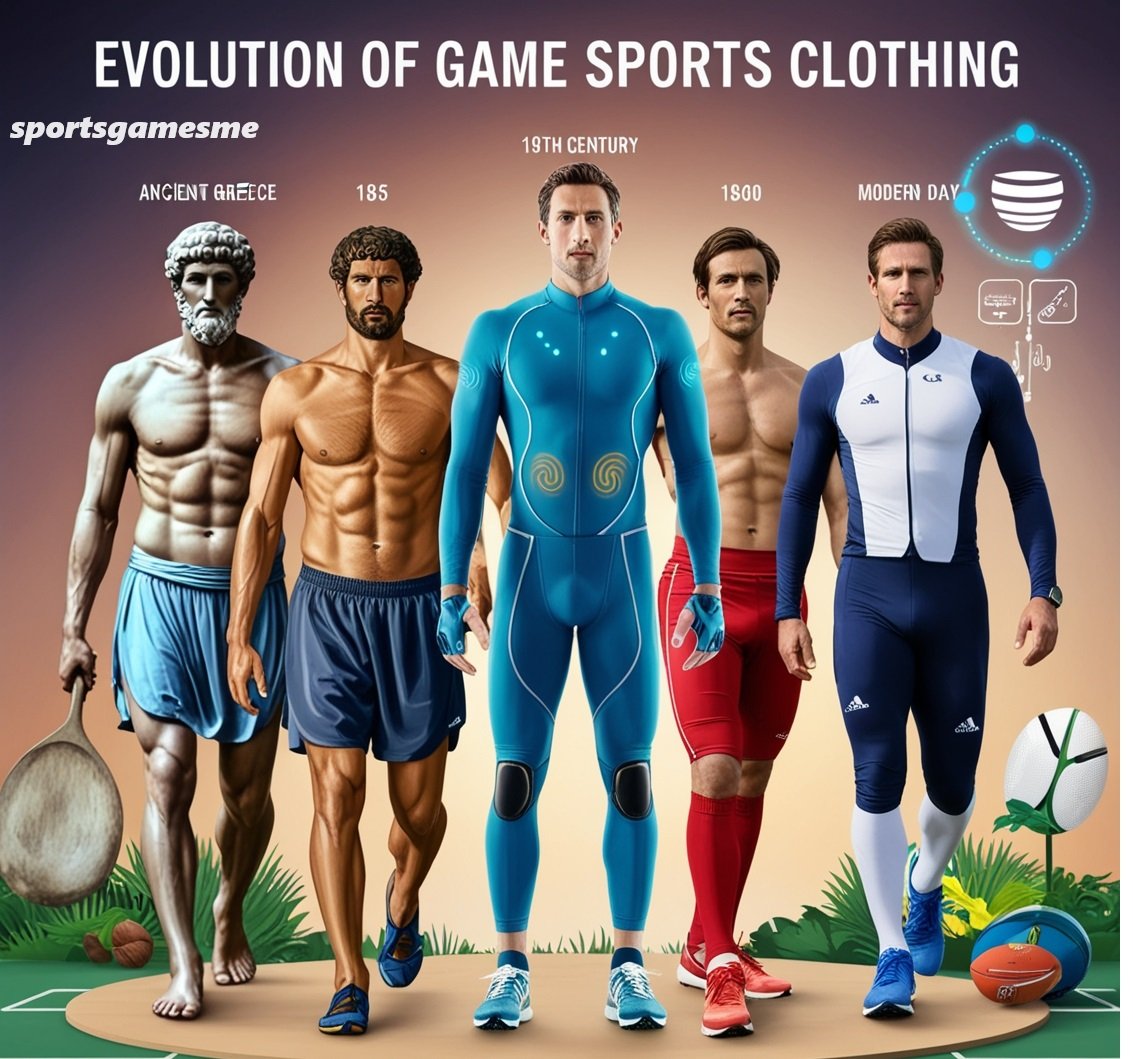Game Sports Clothing Sports and diversions have been fundamental to human civilization for centuries, with their noteworthiness crossing from amusement and entertainment to cultivating a sense of community and individual accomplishment. An often-overlooked but crucial component of this space is amusement sports clothing. Over time, sports clothing has advanced from fundamental articles of clothing planned for security and humility to modern, performance-enhancing adaptations that play a pivotal role in athletes’ victories. This article digs into the history, significance, and future patterns of diversion sports clothing, highlighting how these articles of clothing have gotten to be a basic portion of sports culture.
A Brief History of Game Sports Clothing
The beginnings of sports clothing can be traced back to antiquated civilizations. The antiquated Greeks, who are credited with establishing the Olympic Diversions, competed in negligible clothing or indeed naked, as they accepted this permitted more noteworthy flexibility of development and celebrated the human body’s frame. In any case, as sports got more organized and spread over societies, the need for specialized clothing emerged.
In the 19th century, with the rise of present-day sports, competitors started wearing more organized and particular clothing. The improvement of amusement sports clothing during this time was impacted by the Victorian era’s unobtrusiveness measures and the mechanical revolution’s progressions in texture generation. Fleece, cotton, and material were commonly utilized, but these materials were not perfect for physical movement, as they were overwhelming and held moisture.
The 20th century marked a noteworthy move in sports clothing, driven by innovative headways and a more profound understanding of sports science. Manufactured materials such as nylon, polyester, and spandex were presented, advertising competitors as lighter, more breathable, and adaptable alternatives. These advancements laid the foundation for the high-performance sports clothing we see today.
The Part of Game Sports Clothing in Performance
Modern sports clothing is planned with the athlete’s execution in mind. Each perspective of an athlete’s outfit, from the texture to the fit, is designed to improve execution and give consolation. Underneath are a few key highlights of amusement sports clothing and how it contributes to athletic success:
Moisture Administration: One of the most basic capacities of sports clothing is moisture-wicking. Textures like polyester and nylon are outlined to drag sweat away from the skin and onto the fabric’s surface, where it can vanish rapidly. This makes a difference in controlling body temperature and keeping competitors cool and dry amid intense physical activity.
Compression:
Compression articles of clothing have gotten to be progressively well known among competitors for their capacity to move forward blood circulation and decrease muscle vibration. These articles of clothing give back to muscles and joints, decreasing the hazard of damage and improving recuperation. Compression wear is regularly utilized in sports like running, cycling, and ball, where muscle weakness can be a critical concern.
Thermal Control:
Depending on the wear and the environment, competitors may require clothing that either holds warm or cools the body. For cold-weather sports, materials like downy and merino fleece provide cover, whereas lightweight, breathable textures are utilized in hot-weather conditions. A few sports clothing too joins warm advances, such as phase-change materials, which can retain, store, and discharge warmth to keep up a steady body temperature.
Mobility and adaptability:
Game Sports Clothing The plan and fit of sports clothing are significant for permitting the greatest development. Stretchable textures, like spandex, give the clothing vital adaptability, whereas ergonomic plans guarantee that the clothing moves with the body. This is especially critical in sports like acrobatics, yoga, and military expressions, where a full run of movement is essential.
Protection:
Sports clothing also serves a defensive purpose. In contact sports like football and hockey, adaptations such as cushioned shirts, shorts, and gloves offer assistance to protect competitors from damage. Also, specialized footwear, like cleats for soccer or spikes for track and field, provides solidity and footing on different surfaces, decreasing the chance of slips and falls.
Aerodynamics:
In high-speed sports such as cycling, swimming, and track occasions, streamlined clothing plays a basic part. These articles of clothing are planned to diminish discussion resistance, permitting competitors to move more proficiently through their environment. For illustration, cyclists regularly wear skin-tight suits made from smooth, low-drag materials to shave off valuable seconds in a race.
The Impact of Design on Sports Clothing
While usefulness is foremost in sports clothing, mold has also played a critical role in its advancement. The crossing point of sports and design has given rise to athleisure, a drift that obscures the line between athletic wear and casual clothing. Athleisure clothing is planned to be flexible, advertising both execution benefits and fashion. This trend has been popularized by celebrities, influencers, and major sportswear brands, making sports clothing a staple in ordinary wardrobes.
Moreover, sports groups and competitors have progressively utilized clothing as a form of expression and character. Group shirts, for example, have ended up being images of pride and dependability for fans and players alike. The plan and colors of these shirts regularly reflect the team’s history and culture, creating a solid sense of having a place among supporters.
Additionally, the underwriting of sportswear by high-profile competitors has altogether impacted customer inclinations. Brands like Nike, Adidas, and Beneath Protective Layer have joined forces with rivals to advance their items, driving the far-reaching appropriation of sports clothing beyond the athletic community.
Sustainability in Sports Clothing
As natural mindfulness develops, maintainability has become a basic thought in the generation of sports clothing. The sportswear industry, like numerous others, has confronted feedback about its natural effects, especially in terms of squander and contamination. In reaction, brands are progressively receiving eco-friendly products and materials.
Recycled polyester, natural cotton, and biodegradable textures are presently being utilized to make maintainable sports clothing. Also, a few companies are implementing circular economy standards. Empowering customers to reuse their ancient sports adaptations or advertising take-back programs. These activities, not as they were diminishing squander but as they advanced mindful consumption,.
Moreover, feasible sports clothing is frequently planned for strength, decreasing the need for substitutions. High-quality materials and development strategies guarantee that pieces of clothing can withstand the rigors of athletic execution while keeping up their judgment over time.
The Future of Diversion Sports Clothing
Game Sports Clothing The future of diversion sports clothing is balanced to be molded by mechanical progressions and a developing emphasis on personalization and maintainability. A few developing patterns are likely to impact the following era of sportswear:
- Smart Clothing: The integration of innovation into sports clothing is anticipated to become more predominant. Savvy pieces of clothing prepared with sensors can screen an athlete’s imperative signs, track execution measurements, and give real-time criticism. This information can be utilized to optimize preparation and anticipate wounds, which is a critical advantage for athletes.
- 3D Printing: 3D printing innovation is revolutionizing the generation of sports clothing by permitting the creation of custom-fit pieces of clothing. This innovation empowers producers to deliver clothing custom-fitted to an individual’s correct estimations, making strides in consolation and execution. Moreover, 3D printing diminishes fabric waste and permits more inventive designs.
- Biodegradable Materials: As maintainability gets progressively critical, the improvement of biodegradable sports clothing is likely to pick up footing. These materials, outlined to break down actually after use, offer an ecologically neighborly alternative to conventionally engineered textures. This move may essentially decrease the natural effects of the sportswear industry.
- Personalization: The request for personalized sports clothing is on the rise. Propels in fabricating and planning permit buyers to customize their sportswear, from choosing colors and designs to including individual logos or messages. This drift reflects a broader desire for singularity and self-expression in sports and fashion.
- Sustainable Hones: The future of sports clothing will also see a focus on maintainable hones. Brands are likely to investigate ways to minimize their carbon footprint. Whether through the utilization of renewable vitality in generation, lessening water utilization, or receiving moral labor,. Buyers are becoming more cognizant of the natural and social effects of their purchases, driving brands to prioritize sustainability.
Conclusion
Game sports clothing has come a long way from its humble beginnings, advancing into a significant component of athletic execution and individual expression. As innovation and design progress. The future of sportswear guarantees indeed more noteworthy advancement. Center on maintainability, personalization, and savvy innovation. Whether you’re a tip-top competitor or a casual sports devotee, the clothing you wear plays an imperative part in your execution, consolation, and character. As the industry advances. We can anticipate amusement sports clothing to not only upgrade athletic accomplishments but also reflect our developing commitment to the planet and personal expression.


